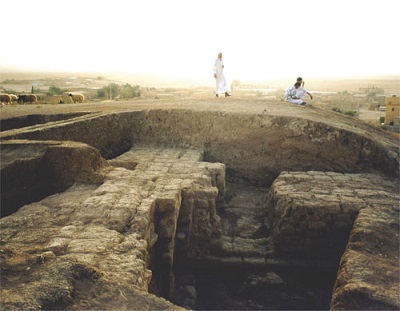Kingdom of NabadaTall Beydar- alHasakeh
Historical site of Tall Beydar lies on a fertile plain 35km north of al- Hasakeh City on the main road of Derbaseyeh- alHasakeh. It seems that a river used to run near the Tall. A joint Syrian-European mission headed by Dr. Antoine Suleiman, a Syrian archeologist, and Dr. Mark Lupo, European, started archaeological excavations there in 1992.
Results of excavations proved that the Tall was settled in 4500BC, an era known as the Age of alUbeid, and reached its culmination in the third millennium, between 2800- 2200 BC, in the age of early dynasties when a local kingdom was established around an urban center and later became an integrated city.
Excavations of recent years revealed that the Tall hosted the local Kingdom of Nabada, an early city-kingdom formed in the «Syrian Jezira» which assumed a distinguished administrative and cultural position.
Nabada was the first city kingdom at the Euphrates Peninsula, established on a large area of 28 acres with a circumference of 2km, and had an acropolis 27m above the level of the kingdom. The city had a double circular wall which indicates that the kingdom was prosperous in the third millennium BC. It flourished because it was situated on the commercial road between Nineva, (Mosul) and Kingdom of Emar, (Maskana) on the Euphrates, and the Mediterranean. When the city expanded it occupied an area of 80 acres, making one of the most important archaeological sites in Syria.
Nabada was a well fortified city with the acropolis surrounded by an external double wall of 150m in diameter with seven main gates; each one was open to a nearby kingdom:
Tall Brak (Najar), Mardin, Diar Bakr, Urkish (Tall Mozan), and the eastern one to Nineva (Mosul), the southern gate to TeppeQora in Sinjar, and the western gate to Tall Khweira and Maskana on the Euphrates.
The city was a meeting point for trade routes and a resort for caravans and travelers. What increased its archaeological importance is the discovery of 230 mud tablets with texts dating back to the 3rd millennium BC, and deals with various subjects, commercial information and trade accounts, as well as social and administrative issues. These tablets are considered the oldest documents ever written in ancient Syria, and they reveal the commercial and civilized relation between Nabada and the kingdoms of Mari and Tarqa.
 The kingdom was distinguished for its architectural achievements, namely the palace complex built on a rectangle of 50X60m and an internal wall, in addition to the 5m thick main wall of the city which was built of mud bricks. The city had a number of temples, squares, streets, houses and warehouses, served by an effective drainage system.
The kingdom was distinguished for its architectural achievements, namely the palace complex built on a rectangle of 50X60m and an internal wall, in addition to the 5m thick main wall of the city which was built of mud bricks. The city had a number of temples, squares, streets, houses and warehouses, served by an effective drainage system.
Life continued in Nabada during the Houri-Mitanian period, 1500- 1400 BC, and during the Assyrian period where techniques of architecture were not far from those followed today in the region of alKhabour when roofs were mostly plain. It seems that the art of architecture retracted during the Assyrian period despite the indications of life during the Ikhminian era.
Recently, the Euro-Syrian mission executed some works of restoration and protection in the site and in the monuments discovered in it. The general shape of the city was cleared up including the main streets and squares.
A huge mud building was builtbased on the building techniquesused by the Nabadians north of thehill, and it is now used as a residencefor the students and archeologists,and as a depot for findings and discoveries.
Haifaa Mafalani

